Site menu:
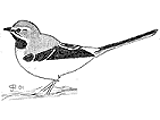
November 2014 Newsletter
Grey Wagtail Migration 2014.
Colour Ring Report.
October Bird News.
Forthcoming Events.
Grey Wagtail Migration 2014
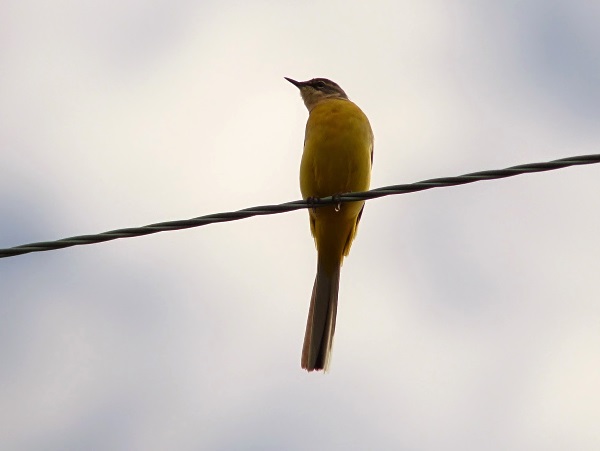
September 2014 saw a large passage of Grey Wagtails through our area,
one of the largest recorded in recent times. The graph below
demonstrates how good a year it was at Red Rocks and the highest daily
count of 26, on Sep 5th, was the largest recorded there since
at
least the 1960's, the previous highest being 22.
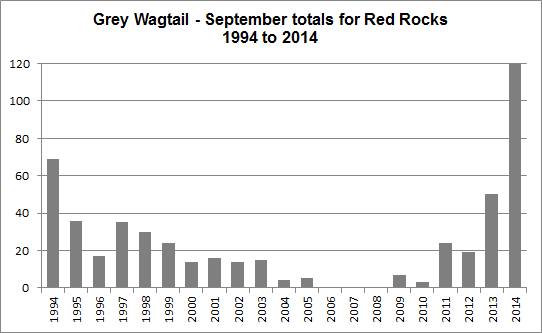
But it wasn't just Red Rocks which saw good numbers with a lot of birds also recorded at both Heswall and Leasowe Lighthouse. Although numbers at Hilbre weren't quite so spectacular they still had the third highest total for the past 12 years there (my Hilbre data for Sep 2014 may not be complete so counts could have been higher). In total 327 birds were recorded in September at these four sites, a small amount of duplication may have occurred but coverage was by no means complete so far more will have been missed than counted twice.
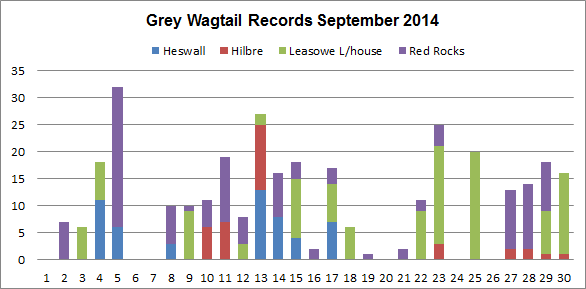
So why was this year's autumn passage so good? The most obvious factor was the fabulous weather we had all September, and the literature indicates a strong link between a good passage and good weather, I quote Sharrock in British Birds "The majority of Grey Wagtail movements occur with the extension of anticyclonic conditions or, more rarely, when weak low pressure systems produce rather similar conditions of light winds and fairlyclear skies ". The other good passage in recent years was on Hilbre in 2002 when the September total there was 150 and I quote from that year's Cheshire and Wirral Bird Report "most days were sunny and clear with easterlies for much of the time". It also helps that they migrate in daylight and, unlike many species which fly high in good weather, they typically fly at less than 10 metres making identification relatively easy. Recent studies have shown the vast majority of these Grey Wagtails which migrate along the coast in autumn are juveniles so breeding success is another very important factor and they had an excellent breeding season in 2014.
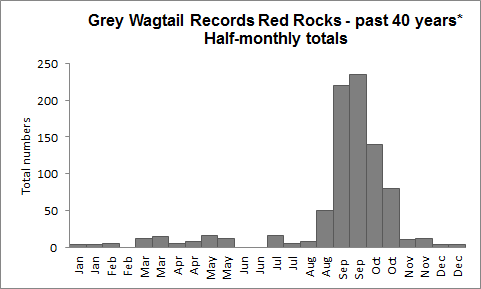
The graph from Red Rocks shows just how concentrated migration is from mid-August to mid-October, with very few in the spring passage and this is typical of most coastal sites. However, Hilbre appears to be an exception with a relatively large numbers in spring and these are likely to be adults crossing Liverpool Bay, or possibly right across the Irish Sea.
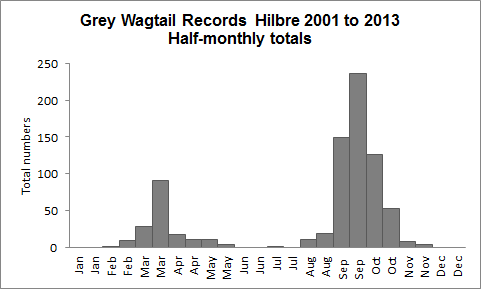
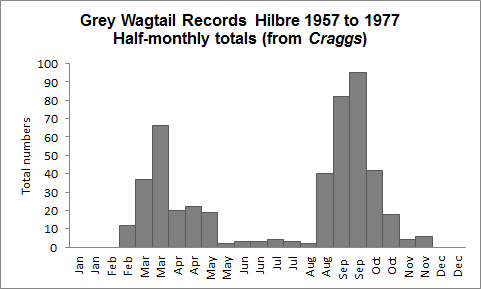
But even on Hilbre it is the movement of juveniles in the autumn which form most of the records and it is interesting to compare the numbers with the closely related Yellow Wagtail which shows a much more typical pattern with records concentrated in spring.
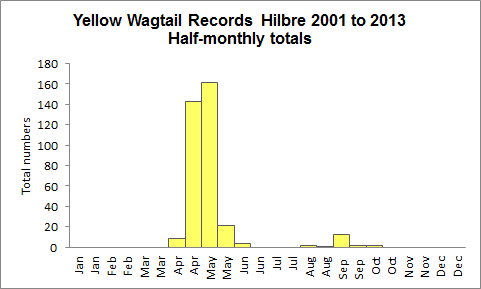
A big difference between the two species is that the Yellow Wagtail is fully migratory, wintering in tropical Africa, whereas Grey Wagtails are partial migrants with many just undergoing altitudinal movements, particularly during cold weather. In fact, surprisingly little is known about Grey Wagtail migration but it does seem that in this country the majority of the adults are largely sedentary and it is the young birds of the year which move comparatively long distances. Many birds probably just move to the south of the UK but ringing records indicate others fly as far as Portugal, in addition there is some evidence that some birds from the continent either move to, or move through, this country during migration.
On Mar 3rd 2014 a ringed Grey Wagtail was found dead at Parkgate and it gives an intriguing hint of where these birds come from. It was ringed as a nestling on May 25th 2013 in Moy which is close to Inverness, thus showing just how far these juveniles fly on their way south. The fact that it was found so early in the year, i.e. before the start of the spring migration, probably means it spent the winter in our area.
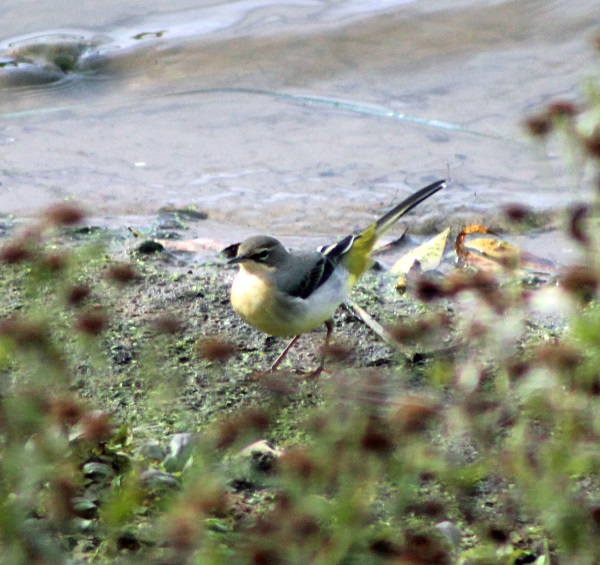
Colour Ringing at Heysham
For the past four years a programme of individual colour ringing of Grey Wagtails has been carried out by Heysham Bird Observatory and a remarkable total of 550 have been ringed including 160 in 2014. All but one of these were juveniles.
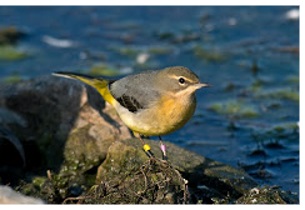 We have seen a
few of these
colour-ringed birds both on the Dee estuary and the
surrounding area with sightings at Connah's Quay, Appleton (near
Widnes) and Seaforth Nature Reserve. Other interesting records include
a Wiltshire sewage farm, a garden pond near Wolverhampton and on
Skokholm
Island, plus several which spent the winter in the Morecambe Bay
area. So far no records from either continental Europe or on their
breeding grounds. Photo left, Colour-ringed Grey Wagtail at Seaforth
Nature Reserve by Steve Young.
We have seen a
few of these
colour-ringed birds both on the Dee estuary and the
surrounding area with sightings at Connah's Quay, Appleton (near
Widnes) and Seaforth Nature Reserve. Other interesting records include
a Wiltshire sewage farm, a garden pond near Wolverhampton and on
Skokholm
Island, plus several which spent the winter in the Morecambe Bay
area. So far no records from either continental Europe or on their
breeding grounds. Photo left, Colour-ringed Grey Wagtail at Seaforth
Nature Reserve by Steve Young.
The following ring combinations are used:
LEFT LEG - a metal BTO ring plus a
colour. It is important to note whether the colour is above or below
the metal ring
RIGHT LEG - TWO colour rings. Some are easier to see than others e.g.
we have had to use grey. All are 'one tone per colour' apart from green
and blue where there are very distinctive dark and light options so
please specify if your sighting includes green or blue. We also use two
of the same colour as part of our sequencing so you might see a 'long
single colour'. From our experience, white and light blue can be quite
tricky to separate in the field, so please take care here.
Please report any colour-ringed Grey
Wagtails to Pete Marsh at PMrsh123@aol.com
, please could you copy myself, Richard Smith - ![]() - I can
then add it to the Dee Estuary Colour-ringed Birds database, many
thanks.
- I can
then add it to the Dee Estuary Colour-ringed Birds database, many
thanks.
1. J.T.R. Sharrock, Grey Wagtail
Passage in Britain in 1956-60, British Birds 57:1, 10-23.
2. Birds of the Western Palearctic, BWPi - Interactive version (2003 -
2006).
3. BTO Migration Atlas, 2002.
4. Cheshire Bird Report 2002, CAWOS.5. CAWOS Records 2001 to 2013.
6. Red Rocks Database (Jane Turner).7. Leasowe and Wirral Birding Blog - lighthousebirding.blogspot.co.uk.
8. Hilbre Bird Observatory Blog - hilbrebirdobs.blogspot.co.uk.
9. J.D. Craggs (Ed), Hilbre The Cheshire Island, Liverpool Universty Press, 1982.
10. Pers. comm. Pete Marsh, Heysham
Bird Observatory, October 2014.
* Red Rocks records go back as far as 1967 but not all years are in the database.
Note also coverage at Red Rocks and the other sites mentioned does differ from day to day and year to year so some caution should be used when interpreting the graphs. However, I have no doubt that the story the graphs tell does represent the true picture.
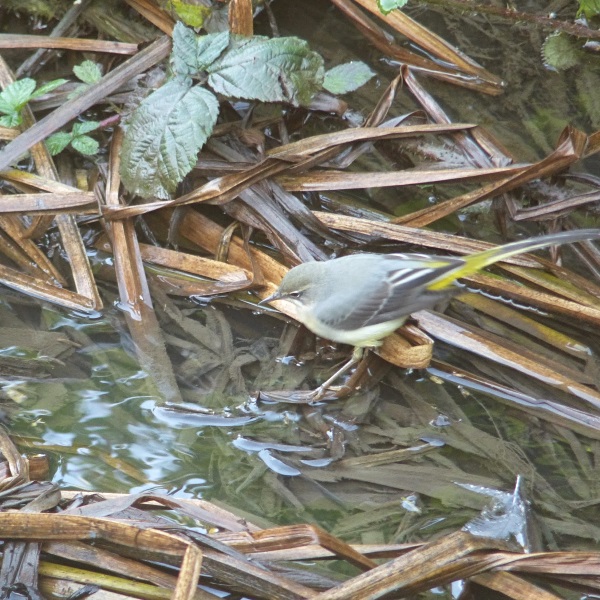
Richard Smith
Top of Page
Colour Ring Report
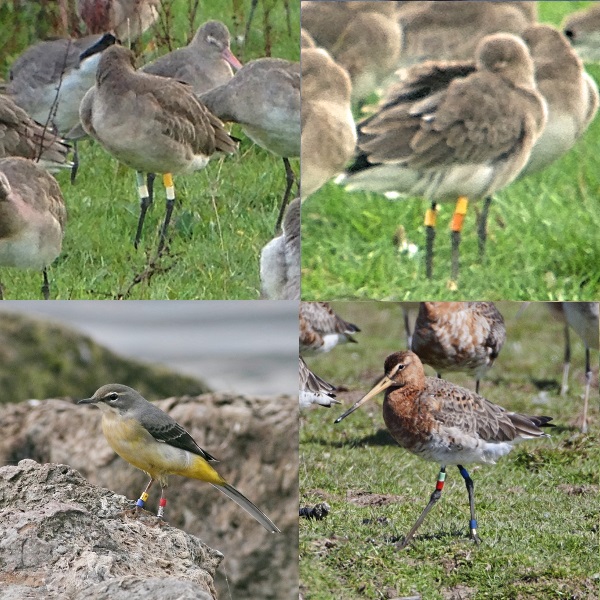
20 different colour-ringed Black-tailed Godwits were recorded during
October, either at Gilroy Nature Reserve (West Kirby) or Thurstaston
Shore. We saw some interesting movements with several of the
godwits first heading to the east/south-east of the country after
arriving back from Iceland before flying back north-west to the Dee
Estuary. The large numbers of gulls along north Wirral included a few
ringed ones, unfortunately the two I saw weren't near enough to read
but thanks to Manu Santa-Cruz four were successfully recorded (we are
still waiting for feedback for one of these).
Black-tailed Godwits
Details of the three godwits shown in the photographs:YW-LW ringed on the Wash as an adult on Aug 8th 1998 which makes this bird at least 18 years old.
Recorded at Gilroy NR, West Kirby, in October 2014.
Between 1999 and 2003 this bird mainly visited sites in Lancashire and first visited the Dee estuary in January 2004. Apart from a few visits to the Wash and the Ouse Washes the bird has been seen back on the Dee estuary every winter from 2006, usually turning up in November and leaving in January - it has become a regular on Thurstaston shore. In 2014 it visited the Wash in August before turning up at Gilroy on Oct 21st which is the earliest we have seen it after the breeding season.
Y-YO//W ringed on the Wash as an adult on Aug 13th 2010.
Recorded at both Gilroy NR, West Kirby, and Thurstaston shore in October 2014.
First record after ringing was at Inner Marsh Farm on August 26th 2012. It then turned up at Thurstaston shore in October and early November 2013. The following February it was in Portugal before being seen in the Netherlands on March 16th 2014, a route many birds follow. There were two records in September 2014 from the Wash before it flew west to the Dee estuary.
LR-B//B ringed in Montrose Basin, Scotland as a juvenile on October 8th 2011.
Recorded six times at Gilroy Nature Park, West Kirby, in October 2014.
We call this 'the Scottish bird' for obvious reasons, we have seen other bird ringed in Scotland but this is our only regular one. For the first winter and early spring after ringing it stayed in the Montrose Basin before heading south to Northumberland on May 18th 2012 where it probably spent the summer. It was at Burton Mere Wetlands on August 6th 2012 and it has been a regular on the English side of the Dee estuary ever since with no records elsewhere.
Gulls
Common Gull
2X1C - Black letters on Orange ring. Ringed as a chick on June 30th 2012 at Tillypronie, Aberdeenshire, Scotland.Recorded on East Hoyle Bank (north Wirral) on September 27th 2014. No other records.
Herring Gull
R4RP - Yellow letters on Black ring. Ringed as a chick on July 7th 2006 on the Ribble Estuary.Recorded on East Hoyle Bank (north Wirral) on September 27th 2014. No other records.
Black-headed Gull
2C93 - White letters on Blue ring. Ringed as a chick on June 11th 2012 at Killington Reservoir, Cumbria.Recorded on East Hoyle Bank (north Wirral) on September 17th 2014. No other records.
Grey Wagtail
mR-OP (m = metal ring, P = bright pink). Ringed as a juvenile at Middleton Nature Reserve (near Heysham) on September 12th 2014.
Recorded at Connah's Quay Reserve on October 27th 2014 (present for at least a week prior to that). No other records.
Photo above is not of this bird which is of a bird at Seaforth Nature Reserve in 2013.
Richard Smith and Matt Thomas.
Colour-ringed birds were also recorded by Steve Hinde, Manu Santa Cruz, Peter Haslem, Richard Beckett, Colin Jones, John Jakeman and David Platt.
October Bird News
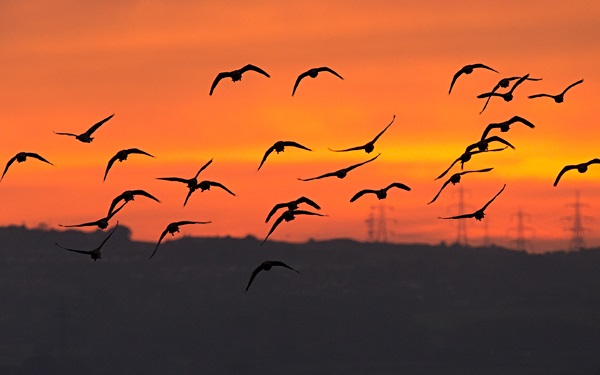
It wasn't a Leach's Petrel free autumn after all but we only got a handful with about four on the 21st and five the next day. More unexpected were a couple of Storm Petrels on the same dates, late for this species. The gales brought in Sabine's Gulls at New Brighton, Hoylake and Point of Ayr, we also got Little Gulls, Kittiwakes, Great Skuas and Arctic Skuas. There were several late Manx Shearwaters on the same dates and these were some of the latest ever recorded, although we have had them as late as December 9th after prolonged southerly gales. A Grey Phalarope sat on the groyne at Meols on the 24th.
The
prolonged mild weather and southerly winds meant many other species
were late leaving, including: a Swift at New Brighton on 18th with a
Swift spp over West Kirby on 21st; a Swallow over Leasowe Lighthouse on
30th; a Grasshopper Warbler heard but not seen (so only a 'probable')
on Caldy Hill on 20th.
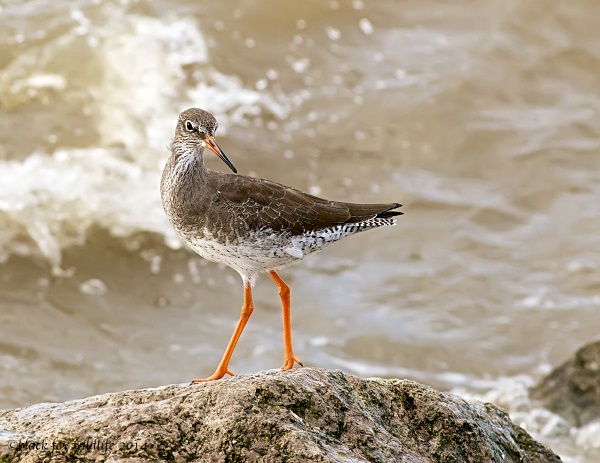
No mega rarities this October but we did get two Cetti's Warblers at Red Rocks, a Velvet Scoter off North Wirral, the Cattle Egret which has taken up residence at Burton Mere Wetlands, a Yellow-browed Warbler at Hoylake and a Siberian Chiffchaff at Red Rocks with a probable at Leasowe Lighthouse.
There were at least three Hen Harriers recorded, an adult grey male and two ringtails, plus a female and at least one juvenile Marsh Harrier.
There were three Curlew Sandpipers on Hoylake shore on the 6th with one also at Heswall, then later in the month a single was present at Burton Mere Wetlands on several days, there were also a few reports of single Little Stints. On the 10th there was an amazing 4,900 Black-tailed Godwits at Gilroy Nature Reserve, West Kirby, and good numbers were present all month there. A remarkable record was of 29 Greenshank on Hoylake shore on the 7th, a site record, they only stayed a short while before heading into the estuary.
There was some visible migration
through the month including 1,880 Chaffinches and a Hawfinch at Red
Rocks with several hundred Fieldfares, Redwings and Starlings at the
end of the month.
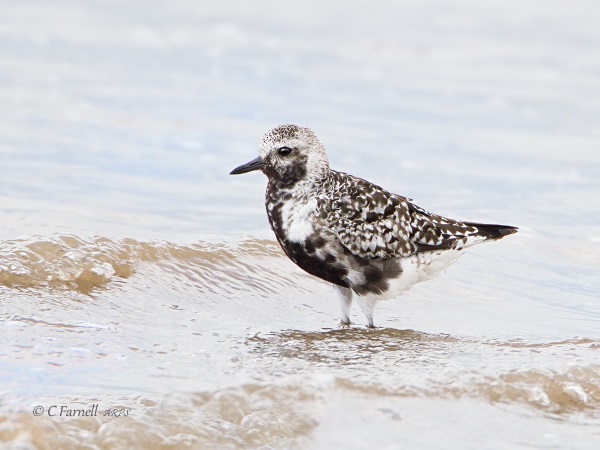
Richard Smith.
What to expect in November
Wader numbers will increase this month and we should get good numbers of Dunlin, Knot and Sanderling roosting at Hoylake, West Kirby and Point of Ayr at high tide. There could be as many as 20 Purple Sandpipers on the pontoon on New Brighton Marine Lake during spring high tides with similar numbers at Hilbre. Given a cold spell Thurstaston Shore at low tide can give fabulous views of Pintail, Shelduck, Teal, Knot and Black-tailed Godwits.
Last winter was poor for Short-eared Owls so lets hope it's better this winter, although unfortunately there are no big high tides forecast to flush them from the marsh. Also expect to see hundreds (hopefully thousands!) of Pink-footed Geese on the marshes together with several Hen Harriers and hopefully a Marsh Harrier will spend the winter. Brent Geese on Hilbre will increase to around 200, these can often be seen off the marsh at West Kirby at high tide.
One or two Snow Buntings should be seen on Hilbre and along north Wirral and sometimes we can get a small flock on the shingle at Point of Ayr.
Top of Page
Forthcoming Events
November Highest Spring Tides (Liverpool)
Also
see Tides
page.
7th November, 10.59hrs (GMT), 9.6m.
8th November, 11.39hrs (GMT), 9.6m.
Forthcoming Events
Organised by the Wirral
Ranger Service , Flintshire
Countryside Service and the
RSPB (Dee Estuary):
All these events and walks have bird interest, even those not
advertised specifically for birdwatching. No need to book for these
events unless specified - please check below.
Also see 2014 Events Diary.
Join the Coastal Rangers, the Dee Estuary Voluntary Wardens and the RSPB on this high tide birdwatch at Hoylake to see large numbers of waders as they gather and roost on the shore.
With a rising tide, we should see the birds at close quarters as they roost and feed. Beginners welcome. Dress warmly and bring binoculars if you have them.
There is no need to book. High tide is at 11.21 am and height 9.6m.
Meet at King’s Gap, King’s Parade, Hoylake.
For further information please telephone Wirral Country Park on (0151) 648 4371.
Sunday 30th November, Skydancers on the Dee Estuary - Donkey Stand, Parkgate.
12noon - dusk
Price: Free
Most people have never seen a hen harrier, but once seen it is rarely forgotten. In support of the RSPB's Skydancer project, we are pleased to bring you a series of events to showcase these enigmatic birds of prey which use the marshes of the Dee Estuary as their home for the winter months.
The name "Skydancer" comes from the aerobatic displays that the male birds perform in their courtship ritual on the moors in the spring. Sadly, this has become an increasingly rare sight and they are close to becoming extinct as a breeding species in England.
This could be the last chance to see Skydancers on the Dee, so come along to Parkgate to find out more about the hen harrier story and what you can do to help save them before it's too late! Look for the RSPB marquee along the main promenade at Parkgate, where friendly staff and volunteers will be on hand with telescopes and binoculars to show you these beautiful, agile birds hunting over the marsh, and coming in to roost there at dusk. Plenty of family activities and other RSPB information will be available.
For more information on the RSPB's Skydancer project, visit
http://www.rspb.org.uk/skydancer/
Directions: The "Donkey Stand" opposite Nicholls Ice-cream shop on The Parade (B5135), Parkgate, Cheshire.